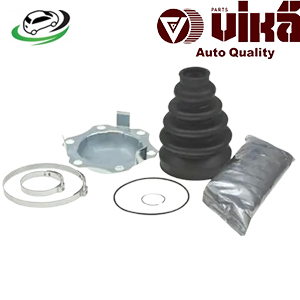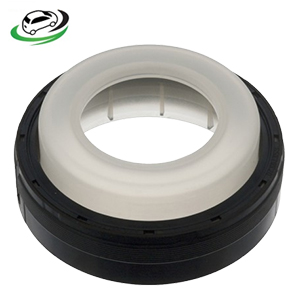-13%
GET Front Crankshaft Oil Seal BMW N43/N45/N46/N52N/N53/N54/N55 Engines 47566
The crankshaft oil seal, often referred to as the “front” or “rear” main seal, is a crucial component in the engine of a vehicle, ensuring that oil stays contained within the engine, particularly around the crankshaft. This seal prevents oil from leaking out where the crankshaft extends from the engine block. To fully understand the importance, function, types, failure modes, and replacement procedures for a crankshaft oil seal, let’s delve into these aspects in detail.
Importance of the Crankshaft Oil Seal
The crankshaft oil seal plays a vital role in maintaining the overall health of an engine. Its primary function is to keep the engine oil from leaking at the point where the crankshaft exits the engine block, which is typically at the front or rear of the engine. Engine oil is crucial for lubricating the internal components of the engine, reducing friction, preventing wear, and aiding in temperature control. If oil leaks from the crankshaft area due to a faulty seal, it can lead to a significant loss of oil, resulting in inadequate lubrication, increased friction, overheating, and potentially catastrophic engine failure.
Location and Types of Crankshaft Oil Seals
Crankshaft oil seals are generally located at both ends of the crankshaft:
- Front Crankshaft Seal: Located at the front of the engine, this seal is often referred to as the timing cover seal or the front main seal.
- Rear Crankshaft Seal: Found at the back of the engine, near the transmission, this is often called the rear main seal.
These seals are designed to handle the rotational motion of the crankshaft while keeping the oil inside the engine. They are usually made from durable materials such as rubber, silicone, or PTFE (polytetrafluoroethylene), which are selected for their resistance to high temperatures and their ability to withstand the constant motion of the crankshaft.
Functionality of the Crankshaft Oil Seal
The crankshaft oil seal is designed to create a tight barrier around the crankshaft, preventing oil from seeping out of the engine. This barrier is achieved through the precise fit of the seal around the crankshaft and its housing. The seal has a lip that rests against the crankshaft, and this lip is usually spring-loaded to maintain constant pressure, ensuring a tight seal even as the crankshaft rotates at high speeds.
Modern crankshaft seals often incorporate additional features such as a dust lip, which helps to keep contaminants like dirt and debris out of the engine, and a wear sleeve, which can be used to cover a damaged or worn crankshaft surface to provide a smooth sealing surface.
Types of Crankshaft Oil Seals
- Lip Seals: These are the most common type of crankshaft oil seals. They consist of a rubber or elastomeric lip that fits tightly around the crankshaft. The lip is often reinforced with a metal spring, known as a garter spring, which helps maintain the seal’s pressure against the crankshaft.
- Teflon Seals: These seals are made from PTFE (Teflon) and are known for their durability and resistance to wear. They are often used in high-performance engines where temperatures and rotational speeds are higher.
- Double Lip Seals: These seals have two sealing lips, one that seals against oil leakage and another that prevents contaminants from entering. Double lip seals are commonly used in more demanding environments where both sealing functions are critical.
Common Causes of Crankshaft Oil Seal Failure
- Wear and Tear: Over time, the constant rotation of the crankshaft can cause the seal to wear down, leading to a loss of elasticity in the rubber, and eventually, oil leaks. The spring inside the seal can also lose tension, further compromising the seal’s effectiveness.
- Improper Installation: If the seal is not installed correctly, it can become misaligned or damaged, leading to leaks. For example, if the seal is installed at an angle, the lip may not properly contact the crankshaft, allowing oil to seep through.
- Crankshaft Surface Damage: If the surface of the crankshaft where the seal sits becomes damaged or worn, the seal may not be able to create an effective barrier. This damage can occur due to improper installation, debris in the oil, or general wear and tear.
- High Engine Pressure: Excessive pressure within the engine can force oil past the seal, especially if the engine’s crankcase ventilation system is not functioning properly.
- Heat and Chemical Exposure: Exposure to high temperatures and engine fluids can cause the materials in the seal to degrade over time, leading to cracks, hardening, or loss of elasticity.
Signs of a Failing Crankshaft Oil Seal
- Oil Leaks: The most obvious sign of a failing crankshaft oil seal is an oil leak near the front or rear of the engine. Oil may drip onto the ground or be visible on engine components.
- Oil on the Flywheel or Clutch: In the case of a rear main seal failure, oil can leak onto the flywheel or clutch, leading to slippage or clutch problems.
- Low Oil Levels: If the seal is leaking, you may notice a drop in engine oil levels. Regularly checking your oil levels can help you catch a leak before it causes major damage.
- Burning Oil Smell: If leaking oil comes into contact with hot engine components, it can create a burning oil smell, which is often noticeable when the engine is running.
Consequences of Crankshaft Oil Seal Failure
A failing crankshaft oil seal can have severe consequences if not addressed promptly. The most immediate concern is the loss of engine oil, which can lead to insufficient lubrication. This can cause increased friction and heat within the engine, potentially leading to engine damage or failure. In addition, an oil leak can cause damage to other engine components, such as the clutch or timing belt, depending on the location of the leak.
Replacing a Crankshaft Oil Seal
Replacing a crankshaft oil seal is a labor-intensive task, often requiring the removal of several engine components, including the timing cover, crankshaft pulley, or transmission. The process generally involves the following steps:
- Disassembly: Depending on whether you’re replacing the front or rear seal, you’ll need to remove various engine components to access the seal. This might include the timing cover, oil pan, crankshaft pulley, flywheel, or transmission.
- Removing the Old Seal: Once you have access to the seal, carefully remove it using a seal puller or a similar tool. Be cautious not to damage the crankshaft or the seal housing during this process.
- Inspecting Components: Before installing the new seal, inspect the crankshaft surface for any damage or wear. If the crankshaft surface is damaged, you may need to use a repair sleeve to provide a smooth surface for the new seal.
- Installing the New Seal: Carefully press the new seal into place, ensuring it is seated evenly and securely. The seal should fit tightly against the crankshaft to prevent leaks.
- Reassembly: After the new seal is installed, reassemble the engine components in the reverse order of removal. Take care to torque all bolts to the manufacturer’s specifications.
- Testing: After reassembly, start the engine and check for leaks. It’s also a good idea to monitor the engine oil level and condition over the next few days to ensure the new seal is functioning properly.
Follow us on Facebook for more parts.



